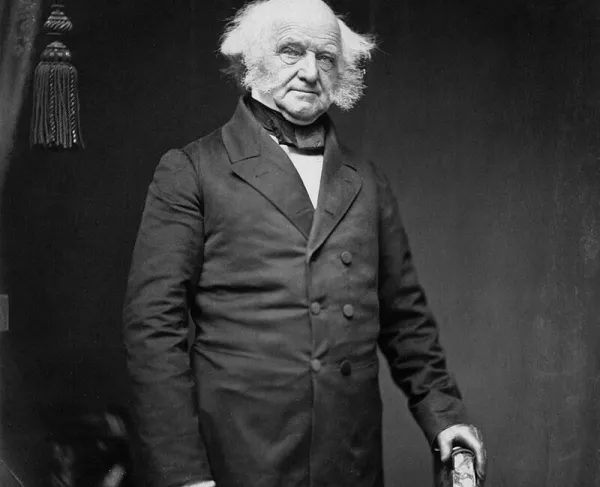Martin Van Buren

Martin Van Buren, the eighth president of the United States, is remembered as the “little magician,” because of his height and extraordinary understanding of political strategy. While many credit Van Buren with being one of the founders of the Democratic Party and being one of the key members of the Jackson coalition, Van Buren’s presidential term was plagued by financial turmoil that eventually resulted in his loss of the White House in the following election.
Van Buren was the third of five children born on December 5, 1782, to Abraham Van Buren, a tavern keeper and farmer, and Maria Hoes Van Alen in Kinderhook, New York. He was the first president born as a United States citizen. Both of Van Buren’s parents had Dutch descent, and his first language growing up was Dutch; therefore he was the first and only president without English as his first language. From a young age, Van Buren became immersed in politics as influential New York leaders like Alexander Hamilton and Aaron Burr visited the family tavern. He was well educated and a student at the town school and Kinderhook Academy. However, he left school as a young teenager and began to work for a Kinderhook lawyer in 1796. Nearly six years later, Van Buren opened his own legal practice. By 1807, Van Buren married Hannah Hoes, and he had four children with her. However, in 1819, she tragically passed away, and Van Buren never remarried.
Van Buren had an extensive political career, and he began by representing the people of the state of New York as a Democratic Republican. By 1812, he ran for the New York Senate, and he ran on the platform of supporting war with Britain and opposing the Bank of the United States. He was attorney general for New York from 1815-1819. As a prominent member of what came to be known as the “Albany Regency,” Van Buren held a tremendous amount of power in the New York political machine, and he contributed to the corrupt system of patronage. As a state official, Van Buren was also part of the “Bucktail Faction,” which was a group that opposed Democratic-Republican Governor DeWitt Clinton and large government.
Van Buren became a national figure once he was elected to the United States Senate in 1821 to represent the state of New York. While in the Senate, Van Buren continued to advocate for small government, and he brought together a coalition in 1824 to oppose President John Quincy Adams. This coalition formed into what is known today as the Democratic Party. In 1828, Van Buren resigned from the Senate and ran for governor of New York, but once Andrew Jackson was elected, Van Buren had to resign to become his secretary of state. As a member of the Jackson cabinet, Van Buren became one of Jackson’s closest allies. When a scandal surrounding the Secretary of War’s marriage pushed Jackson to dismiss most of his cabinet and Vice President Calhoun, Van Buren stood by Jackson and was offered the position of United States Minister to England. However, he did not remain in this position for long because he was called to be vice president for Jackson’s second term.
Van Buren’s tenure as vice president propelled him all the way to the presidency. He won the election of 1836 with the help of a Jackson endorsement. By 1837, Van Buren was inaugurated into the White House, and he was the first president to mention “slavery” in an inaugural address, which reinforced his support for the existence of the institution. However, Van Buren could only rely on the support of Jackson for so long. Van Buren had inherited the Panic of 1837, which was an economic depression that resulted due to a Jackson era policy that transferred funds from the Bank of the United States to state banks. Van Buren continued to oppose the creation of a national bank, and he supported an independent treasury system for any federal transactions. Van Buren continued to enact Jackson’s deflationary policies; this policy proved to be disastrous, and it led to Van Buren’s fall in popularity.
Furthermore, Van Buren remained unpopular because of how he handled the Second Seminole War in Florida and his refusal to support annexation of Texas. Van Buren believed an annexation of Texas would lead to the expansion of the institution of slavery and war with Mexico. It was a combination of Van Buren’s failure to deal with various crises that ultimately led to his demise and losing the White House in 1840 to Whig candidate William Henry Harrison.
Four years later, Van Buren launched another bid for the presidency, but he lost the Democratic nomination to pro-Texas annexation candidate James K. Polk. In 1848, Van Buren launched his last bid for the presidency as a candidate in the Free-Soil party, which opposed expansion of slavery into newly acquired territories. The 1848 election was the end of Van Buren’s political career, and he retired back to Kinderhook, New York, and the Lindenwald estate. In his retirement years, Van Buren remained an outspoken advocate for free soil policies. Van Buren lived to watch the United States plunge into a Civil War just before dying in 1862 in his home in Kinderhook.
The “little magician” was a man of political strategy. He was an expert on the inner workings of New York politics and the early Democratic Party. However, once Van Buren came to the spotlight as President of the United States, he dealt with the financial turmoil and divide over slavery that would propel the United States closer to Civil War.





